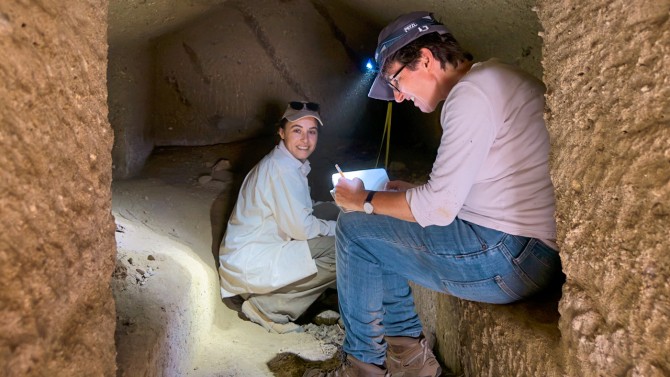From the Greeks and the Romans to the Ottoman empire, the history of Sardis, Turkey is one of persistent turnover. But its archaeological investigation has been remarkably consistent. Since 1958, the ancient city has been continuously excavated by one of the longest-running institutional projects, the Harvard-Cornell Exploration of Ancient Sardis.
"It's really important that it has institutional continuity," said Benjamin Anderson, associate professor of history of art and visual studies in the College of Arts and Sciences. "Many of us know and have been mentored by colleagues of the previous generation of excavators. As a result, it's one of the few long-term archaeological projects in the region that has generated a critical mass of data."
For the last several years, Anderson has been documenting the walls and structures of the city's acropolis, which was a major part of the settlement in the Byzantine period, following Roman times.
"This is a city that shows up in lots of ancient historical sources," he said. "But now, just in the last 75 years or so, we have the possibility of telling that story, also, through what the project has found archaeologically."
Doctoral student Leyla Uğurer and Annetta Alexandridis, associate professor of the history of art and classics, document a rock-cut tomb.
This summer, thanks to the efforts of the project as well as the local community that has played a critical role in the excavation, the site was inscribed in the list of UNESCO World Heritage sites.
"The opportunity to really start understanding a culture through the material remains is pretty unusual, and it requires that kind of long-term commitment," Anderson said. "That's also what's being celebrated by the World Heritage designation by UNESCO. This project has always been distinguished from the very beginning by a desire to communicate results and to make their work legible to tourists and to locals and all manner of different audiences."
'A really large-scale exploitation'
A capital of the Iron Age empire of Lydia, located between the Mediterranean Sea and the Anatolian plateau, Sardis was "a place of cultural encounter between the East and West," according to Annetta Alexandridis, associate professor of the history of art and classics in A&S.
The Lydian period is of particular interest for archaeologists and historians. The Lydians are credited with the invention of coinage, and their ruler, King Croesus, was fabled to be the wealthiest man in the world. The Lydian empire was eventually conquered by Alexander the Great. Several centuries later, it was integrated into the Roman Empire, and then the Byzantine and Ottoman empires.
"Because it was not over built by a modern city - it's only a little village - Sardis gives you a really long history, from the Bronze Age, third millennium BCE, to basically today," Alexandridis said. "These layers are all there, and make it sometimes difficult to excavate, because they are not clearly stratified. They interfere with each other, but, in a way, it's an ongoing history, and that makes it so fascinating for us."
As associate director of the project, Alexandridis has been studying the city's Roman funerary culture and is now conducting a survey of all its cemeteries, which so far have not been well-documented, unlike the Bin Tepe cemetery, about 10 kilometers north of Sardis, which features some of the largest tumuli - i.e., burial mounds - on record.
Sardis also played an important role in the development of American archaeology. The first modern attempt to exhume the city in the early 20th century, as led by the American Society for the Excavation of Sardis, was "a really large-scale exploitation," Alexandridis said. The Temple of Artemis and the necropolis were excavated, but many artifacts were damaged, lost or ended up in the U.S. by dubious means, including a giant column that is still prominently displayed in the Metropolitan Museum of Art. That initial excavation ceased with the Greco-Turkish war in the early 1920s. Slowly, over the decades, artifacts began to trickle back to Turkey.
"It's one of the first cases where we can see the whole discussion about restitution of antiquities that were illegally exported, until some were returned to Turkey," Alexandridis said. "It has all of these broader issues of how to deal with cultural heritage from a not only preservation or scholarly point of view, but also political and legal, and of the question of stewardship and responsibility for culture in the past."
The collaboration between Cornell and Harvard originated in 1958 under the direction of Harvard's George M. A. Hanfmann and Cornell's Henry Detweiler from the College of Architecture, Art and Planning, who specialized in the documentation of historical structures.
"If you went to Sardis in 1950 there were a few things kind of sticking up above ground, but there was nothing really to see, per se," Anderson said. "The architects were the first generation of Cornellians who were there, and the project really committed to taking what they'd excavated responsibly, supplementing it through newly manufactured pieces, and presenting a total experience of the structure, instead of just producing a drawing and putting it in a publication."
In the 1950s and 1960s, the team rebuilt a monumental bath-gymnasium complex and the largest synagogue in the ancient world, projects that were the first of their kind and served as models for reconstructions at other sites.
There followed the discovery of city mud brick walls, the acropolis, a Persian-period garbage pit, a site for gold refinement, an ancient shopping center and, recently, a sanctuary plaza that required 15 years of excavation work.







